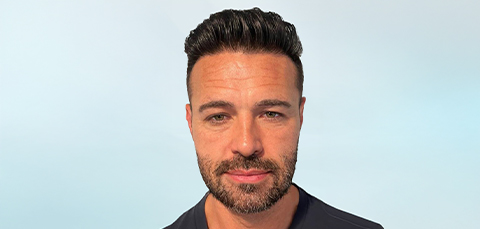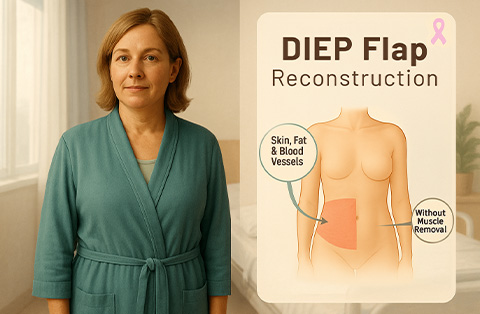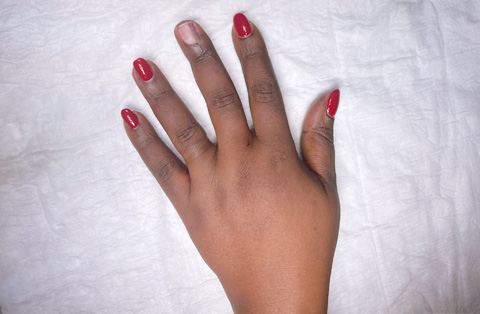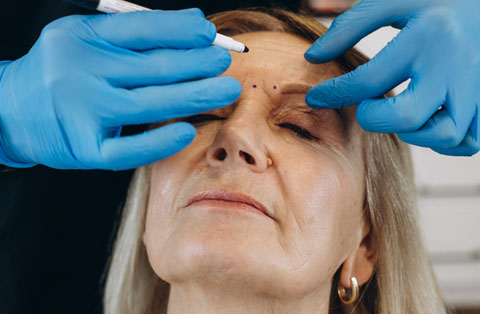Struggling with thinning hair? Discover proven treatments for male pattern baldness that can slow loss, restore density, and boost confidence when started early.
Male pattern baldness, or androgenetic alopecia, is a common type of hair loss caused by genetics and hormonal changes. It typically starts with a receding hairline or thinning crown and can progress over time.
By age 50, up to half of men will experience some degree of male pattern hair loss. While it’s not harmful to physical health, it can significantly affect appearance, confidence, and quality of life.
This article explains what male pattern baldness is, why it happens, and how it progresses. We’ll cover diagnosis, treatment options, lifestyle changes, and emerging therapies so you can make informed decisions about preserving and restoring your hair.
What is Male Pattern Baldness?
Male pattern baldness, or androgenetic alopecia, is the most common type of hair loss in men. It results from a combination of genetic predisposition and hormonal changes, particularly sensitivity to dihydrotestosterone (DHT). This condition causes hair follicles to shrink over time, leading to thinner strands and shorter growth cycles.
Hair loss typically follows a predictable pattern. It starts with a receding hairline at the temples or thinning at the crown. Over time, these areas may merge, leaving a horseshoe-shaped band of hair around the sides and back of the scalp.
Male pattern baldness can begin as early as the late teens but is more common after age 30. While it is not a medical threat, it often affects self-image and confidence, leading many men to seek treatment or preventive measures.
How Common is Male Pattern Baldness?
According to American Hair Loss Association, Androgenetic alopecia is the reason behind %95 of hair loss in men. Androgenetic alopecia is the reason for 95% of male hair loss, according to the American Hair Loss Association. By age 50, two-thirds of American men experience significant hair loss, and 85% experience thinning hair.
By midlife
According to Male Androgenetic Alopecia research, male androgenetic alopecia affects 30–50% of men by age 50
MedlinePlus estimates that over 50% of men over 50 have some degree of hair loss.
By age milestones
About 20% of men in their 20s experience some pattern hair loss, 30% in their 30s, increasing to higher rates in subsequent decades; according to Prevalence of male pattern hair loss in 18-49 year old men research.
Early adulthood
Among men aged 18–29, 16% show moderate-to-extensive hair loss; according to Prevalence of male pattern hair loss in 18-49 year old men research.
What Causes Male Pattern Baldness?
Male pattern baldness develops due to genetic factors and hormonal influences. The primary hormone involved is dihydrotestosterone (DHT), a derivative of testosterone. In genetically susceptible men, hair follicles are more sensitive to DHT. This sensitivity causes follicles to shrink, produce thinner hairs, and shorten the hair growth phase.
Genetics determine both the likelihood of developing the condition and the pattern of hair loss. The trait can be inherited from either parent, although multiple genes are often involved.
While DHT is the main trigger, other factors can influence onset and progression. Age increases risk, with changes often becoming noticeable after the mid-20s. Certain medical conditions, medications, or lifestyle factors may accelerate loss but do not cause the underlying pattern baldness.
Why male pattern baldness occurs?
Genetic predisposition: Inherited genes make hair follicles more sensitive to hormonal effects.
Dihydrotestosterone (DHT) sensitivity: DHT binds to susceptible follicles, causing them to shrink over time.
Follicle miniaturization: Gradual reduction in follicle size leads to thinner, shorter hair strands.
Shortened growth cycle: The anagen (growth) phase becomes shorter, reducing hair length and density.
Age-related changes: Risk and severity increase with age, often becoming more visible after the mid-20s.
Polygenic inheritance: Multiple genes, from either parent, influence onset and pattern.
Accelerating factors: Illness, certain medications, and lifestyle stressors can speed progression but don’t cause the condition.
How Do Genetics and Hormones Cause Male Pattern Hair Loss?
Genetics and hormones work together to trigger male pattern hair loss. Men inherit specific genes that make their hair follicles sensitive to androgens, especially dihydrotestosterone (DHT). DHT is produced when the enzyme 5-alpha-reductase converts testosterone.
In genetically susceptible follicles, DHT binds to androgen receptors, altering the hair growth cycle. This shortens the anagen (growth) phase and extends the resting phase, causing hairs to grow shorter and thinner with each cycle. Over time, follicles shrink to the point where they produce only fine, barely visible hairs or stop producing hair entirely.
The inherited sensitivity to DHT determines not only if a man will develop baldness but also when it begins and how quickly it progresses. Multiple genes contribute, and they can be passed down from either the mother’s or father’s side of the family.
Why Does DHT Shrink Hair Follicles in Pattern Balding?
Dihydrotestosterone (DHT) shrinks hair follicles in male pattern baldness because it alters how genetically susceptible follicles function. When DHT binds to androgen receptors in these follicles, it changes the expression of certain growth-regulating genes. This disrupts the normal hair cycle by:
Shortening the growth (anagen) phase: Hair spends less time growing, so each strand becomes shorter.
Prolonging the resting (telogen) phase: Follicles stay inactive longer before producing new hair.
Reducing follicle size (miniaturization): The hair bulb and shaft diameter shrink with each cycle.
Producing finer, weaker hairs: Over time, thick terminal hairs turn into soft, non-pigmented vellus hairs.
In advanced stages, prolonged DHT exposure can cause some follicles to stop producing hair altogether. The effect occurs only in follicles with a genetic sensitivity to DHT, which is why hair on the sides and back of the head often remains unaffected.
What Is the Role of 5-Alpha-Reductase in Male Hair Loss?
5-alpha-reductase is an enzyme that plays a central role in male pattern hair loss by converting testosterone into dihydrotestosterone (DHT). This process occurs in various tissues, including the skin, hair follicles, and prostate.
There are two main types of 5-alpha-reductase relevant to hair loss:
Type I: Found mainly in the skin and sebaceous glands.
Type II: Found in hair follicles and the prostate; most closely linked to follicle miniaturization in androgenetic alopecia.
In men with genetic susceptibility, higher activity of type II 5-alpha-reductase in scalp follicles increases local DHT levels. This DHT binds to androgen receptors, triggering the progressive shrinking of follicles in affected areas.
Blocking this enzyme (such as with medications like finasteride) can reduce scalp DHT levels and slow or halt hair loss progression in many cases.
What Are the Stages of Male Pattern Balding?
Male pattern balding progresses in recognizable stages, most often described using the Hamilton-Norwood scale. This scale maps the typical sequence and severity of hair loss:
How Do Norwood-Hamilton Stages Map Hair Loss Progression?
Stage 1 – No significant hair loss
Hairline is full with minimal or no recession.Stage 2 – Early hairline recession
Slight recession at the temples, forming a subtle “M” shape.Stage 3 – Deepening recession
Hairline recedes further at the temples; early thinning may appear on the crown.Stage 3 Vertex – Crown thinning begins
Clear balding spot develops on the crown while frontal recession continues.Stage 4 – Enlarged crown bald spot
Crown and frontal recession deepen, separated by a band of hair across the mid-scalp.Stage 5 – Bridging hair thins
The mid-scalp bridge narrows as crown and frontal balding areas grow closer.Stage 6 – Areas merge
The crown and frontal balding regions connect, leaving only hair at the sides and back.Stage 7 – Advanced baldness
Only a thin horseshoe-shaped band of hair remains around the sides and back of the scalp.
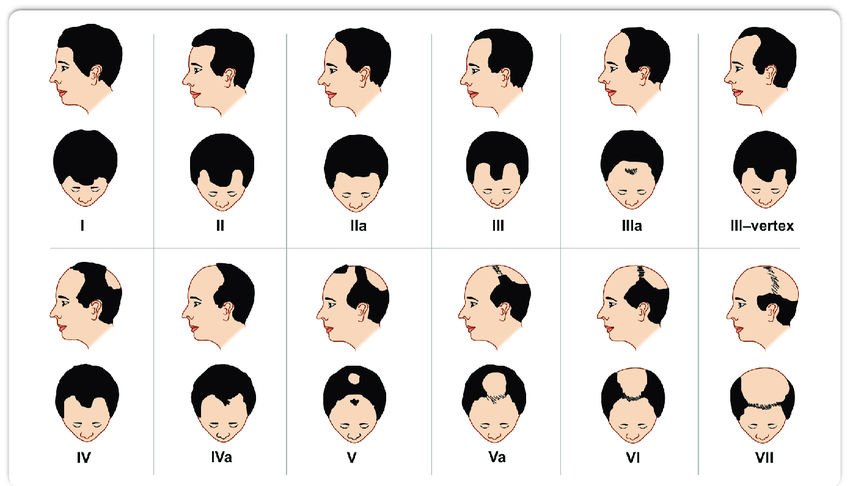
Image Source: In book: Scalp and its disordersChapter: Androgenetic AlopeciaPublisher: Jaypee publishingEditors: S Sacchidanand, S Somiah
The speed of progression varies widely. Some men take decades to move between stages, while others progress rapidly within a few years.
When Does Male Hair Loss Become Permanent Baldness?
Male hair loss becomes permanent baldness when affected follicles undergo irreversible miniaturization. In this stage, the follicle shrinks so much that it can no longer produce thick terminal hairs. Instead, it either produces fine, non-pigmented vellus hairs or stops producing hair altogether.
This change happens after prolonged exposure to dihydrotestosterone (DHT) in genetically susceptible follicles. Once the follicle’s stem cells are inactive and the surrounding tissue structure degenerates, regrowth is no longer possible without surgical intervention.
The transition to permanent baldness can vary widely. In some men, it occurs within a few years of noticeable thinning. In others, progression is slow and partial, with stable areas remaining for decades. Early treatment is most effective because it works best while follicles are still capable of producing terminal hairs.
How Is Androgenic Alopecia Diagnosed?
Androgenic alopecia is diagnosed through a combination of medical history, physical examination, and, when needed, supportive tests.
Key steps in diagnosis:
Medical history: The doctor asks about onset, progression, and family history of hair loss, as well as any recent illnesses, medications, or stressors.
Scalp examination: Visual inspection identifies the typical pattern of thinning, such as frontal hairline recession or crown balding.
Hair pull test: A gentle pull on a group of hairs checks for excessive shedding.
Dermatoscopy: A handheld device magnifies scalp and hair follicles to confirm miniaturization patterns.
Rule-out testing: Blood tests may be ordered to exclude other causes of hair loss, such as thyroid disease, iron deficiency, or hormonal imbalances.
Biopsy (rare): A small scalp sample may be examined under a microscope if the diagnosis is unclear.
In most men, the diagnosis is made clinically because the pattern, progression, and patient history strongly suggest androgenic alopecia.
Which Medical Tests Confirm Male Pattern Hair Loss?
Most cases of male pattern hair loss are diagnosed without laboratory tests, but certain medical tests can help confirm the diagnosis or exclude other causes of hair loss:
Hormone profile: Measures testosterone, dihydrotestosterone (DHT), and sometimes other androgens if an endocrine disorder is suspected.
Thyroid function tests: Detects hypo- or hyperthyroidism, which can cause diffuse hair loss.
Ferritin and iron studies: Checks for iron deficiency, which can worsen hair shedding.
Vitamin D and B12 levels: Identifies nutritional deficiencies that may contribute to hair thinning.
Scalp biopsy: Confirms follicle miniaturization and rules out inflammatory or scarring alopecias in unclear cases.
Dermatoscopic imaging: Uses magnification to document miniaturized hairs, hair shaft diameter variation, and reduced follicle density typical of androgenetic alopecia.
These tests are generally ordered when hair loss appears atypical, progresses unusually fast, or doesn’t match the classic male pattern.
What Treatments Are Available for Male Pattern Hair Loss?
Treatments for male pattern hair loss aim to slow progression, stimulate regrowth in active follicles, or restore hair through surgical methods. Options include:
Medications
Minoxidil (topical): Widens blood vessels in the scalp, improving follicle nutrient supply and extending the growth phase. Available in 2% and 5% solutions or foam.
Finasteride (oral): Blocks type II 5-alpha-reductase, reducing scalp DHT levels and slowing follicle miniaturization.
Dutasteride (oral, off-label): Inhibits both type I and II 5-alpha-reductase; may be more potent than finasteride.
Procedural treatments
Hair transplant surgery: Moves DHT-resistant follicles from the sides and back of the head to thinning or bald areas.
Scalp micropigmentation: Creates the appearance of fuller hair with medical tattooing.
Low-level laser therapy (LLLT): Uses light energy to stimulate follicle activity.
Supportive measures
Nutritional optimization: Corrects deficiencies that may worsen shedding.
Gentle hair care: Avoids traction, harsh chemicals, and excessive heat styling.
Results vary by individual, and treatment is most effective when started early, before permanent follicle loss occurs. Combination therapy often yields better outcomes than single treatments.
Related Article: How To Stop Alopecia Areata from Spreading?
How Do Minoxidil and Finasteride Promote Hair Growth?
Minoxidil and finasteride work through different mechanisms but both can stimulate hair growth and slow hair loss in male pattern baldness.
Minoxidil: This topical treatment widens blood vessels in the scalp, improving blood flow and nutrient delivery to hair follicles. It extends the anagen (growth) phase, allowing hairs to grow longer and thicker before shedding. Minoxidil also increases follicle size, which helps reverse some miniaturization.
Finasteride: This oral medication blocks type II 5-alpha-reductase, the enzyme that converts testosterone into dihydrotestosterone (DHT). Lower scalp DHT levels reduce follicle shrinkage in genetically susceptible areas, allowing existing hairs to remain in the growth phase longer. By preserving follicle health, finasteride helps maintain density and indirectly stimulate hair growth where follicles are still active.
When used together, minoxidil and finasteride target both the hormonal and local scalp factors that drive male pattern hair loss, often producing better results than either treatment alone.
Can Low-Level Laser Therapy Treat Male Pattern Baldness?
Low-level laser therapy (LLLT) is a non-invasive treatment option for male pattern baldness that uses specific wavelengths of light to stimulate hair follicles. The light energy penetrates the scalp and increases cellular activity in follicle cells, improving blood flow and nutrient delivery.
This process can prolong the anagen (growth) phase, increase hair shaft thickness, and slow the rate of follicle miniaturization. LLLT is usually delivered through devices such as laser combs, helmets, or caps used several times per week.
Clinical studies show that LLLT can benefit men with early to moderate hair loss, especially when combined with medications like minoxidil or finasteride. However, its effects are generally less dramatic than surgical restoration and depend on consistent, long-term use.
Is Platelet-Rich Plasma Effective for Male Hair Loss?
Platelet-rich plasma (PRP) therapy is an emerging treatment for male and female pattern hair loss that uses the patient’s own blood components to stimulate follicle activity. In this procedure, blood is drawn, processed to concentrate platelets, and injected into thinning areas of the scalp.
Platelets release growth factors that promote cell repair, improve blood supply, and extend the anagen (growth) phase of hair follicles. This can lead to thicker hair shafts and reduced shedding in active follicles.
Research suggests PRP is most effective in early to moderate stages of hair loss and often works best when combined with established treatments such as minoxidil or finasteride. While results vary, many patients notice improved density and hair quality after a series of monthly sessions followed by maintenance treatments.
When Is Hair Transplant Surgery the Best Treatment for Baldness?
Hair transplant surgery is often the best treatment for baldness in men who experience hair loss that has stabilized and reached a predictable pattern. This is because the procedure relocates DHT-resistant follicles from the sides and back of the scalp to thinning or bald areas, providing permanent coverage.
Ideal candidates typically have:
Sufficient donor hair density to achieve natural-looking results
Hair loss that is not rapidly progressing
Realistic expectations about coverage and density
Surgery is most effective for men with advanced thinning where medical treatments alone cannot restore density. It can also be an option for those who cannot tolerate or have not responded well to medications like finasteride or minoxidil.
While age is not a strict barrier, many surgeons recommend waiting until the mid-20s or later to ensure the hair loss pattern is clear, which helps prevent the need for multiple corrective procedures.
Could Combination Therapies Improve Pattern Balding Outcomes?
Combination therapies for male pattern baldness target different causes of follicle miniaturization, which may help slow progression and improve regrowth. Men who lose hair due to genetic sensitivity to dihydrotestosterone (DHT) often benefit from using treatments with complementary mechanisms.
For example, pairing finasteride (to lower scalp DHT) with minoxidil (to extend the hair growth phase) addresses both hormonal and local scalp factors. Adding low-level laser therapy or platelet-rich plasma can further stimulate follicle activity.
Using multiple approaches can enhance results compared to single treatments, especially in early and moderate stages of hair loss. This strategy may help maintain density for longer and reduce the need for surgical restoration. Consistency and ongoing use are critical, as stopping treatment often leads to renewed thinning.
How Can Lifestyle Changes Support Hair Growth in Men?
Lifestyle changes can support hair growth in men by improving scalp health, reducing stress, and addressing nutritional gaps that may contribute to thinning of the hair. While these changes cannot reverse genetic male pattern baldness, they can create optimal conditions for follicle function and slow additional shedding.
Key strategies include:
Balanced diet: Adequate protein, iron, zinc, vitamin D, and B vitamins help maintain healthy hair structure and growth cycles.
Stress management: Chronic stress can trigger shedding through hormonal changes; techniques like mindfulness, exercise, and adequate sleep can help.
Scalp care: Regular cleansing and gentle massaging improve circulation and reduce buildup that can hinder follicle function.
Avoiding harsh styling: Limiting heat, tight hairstyles, and chemical treatments prevents breakage and further weakening of hair shafts.
Regular health checks: Managing conditions like thyroid disorders or nutrient deficiencies supports overall hair health.
These measures are most effective when combined with medical treatments for male pattern hair loss, helping to protect existing hair and improve overall scalp condition.
Does Nutrition Influence Male Pattern Hair Loss?
Nutrition does not cause male pattern hair loss, but it can influence its severity and the overall health of remaining hair. Male pattern baldness is driven by genetics and hormonal sensitivity to dihydrotestosterone (DHT), yet poor nutrition can worsen thinning and slow regrowth in active follicles.
Key nutrients that support hair health include:
Protein: Essential for keratin production, the main structural component of hair.
Iron and ferritin: Low levels can increase shedding and reduce hair shaft thickness.
Vitamin D: Important for follicle cycling and growth.
Zinc: Supports tissue repair and regulates scalp oil production.
B vitamins (especially biotin, B12, folate): Aid in cell division and hair shaft strength.
A balanced diet rich in these nutrients helps maintain the quality of existing hair and optimizes the results of medical treatments, but it cannot stop the genetic process behind androgenetic alopecia.
Can Stress Management Slow Hair Loss Progression?
Stress management can help slow hair loss progression in some men, especially when stress is contributing to temporary shedding alongside male pattern baldness. While stress does not cause androgenetic alopecia, it can trigger telogen effluvium—a condition where more hairs than usual enter the resting phase—making thinning more noticeable.
Reducing chronic stress can stabilize the hair growth cycle and protect vulnerable follicles. Effective strategies include:
Regular exercise: Improves circulation and reduces stress hormones like cortisol.
Mindfulness practices: Meditation, deep breathing, or yoga support hormonal balance.
Adequate sleep: Restorative sleep promotes overall cellular repair, including in hair follicles.
Balanced schedule: Avoiding overwork and setting aside recovery time prevents prolonged stress exposure.
By lowering stress-related shedding, these measures help maintain density and improve the visible results of medical or surgical hair loss treatments.
What Psychological Effects Can Hair Loss Have on Men?
Hair loss affects many men not only physically but also psychologically, often influencing self-image and confidence. For some, noticing hair loss can trigger feelings of anxiety, frustration, or even mild depression. Men may perceive themselves as less attractive, which can impact dating, social interactions, and professional self-assurance.
The emotional impact varies. Younger men often report a stronger negative reaction, as baldness may feel out of place for their age. Social pressure and cultural ideals around hair can intensify these feelings. Over time, some adapt and accept the change, while others continue to experience reduced self-esteem.
Addressing these effects may involve early treatment, counseling, or support groups. In many cases, taking proactive steps (whether through medical therapies or lifestyle adjustments) can help restore both appearance and confidence.
What New Treatments Target Androgenic Alopecia?
New treatments for androgenic alopecia are expanding beyond traditional medications, offering more targeted ways to slow hair loss and stimulate regrowth. Dermatologists are increasingly exploring therapies that work at the cellular and molecular level.
Promising options include:
Janus kinase (JAK) inhibitors: Originally developed for autoimmune conditions, these drugs may help restore hair growth by modulating inflammatory pathways.
Stem cell–based treatments: Using stem cell–derived growth factors or exosomes to rejuvenate dormant follicles.
Wnt signaling activators: Targeting pathways that control follicle development and cycling.
Microneedling with topical agents: Enhances absorption of growth-promoting solutions such as minoxidil or peptides.
Advanced low-level laser devices: Offering improved wavelength precision for deeper follicle stimulation.
While many of these approaches are still in clinical trials, dermatologists see them as potential complements to existing therapies like finasteride and minoxidil, especially for patients seeking alternatives or enhanced results.
Are Topical Anti-androgens and Stem-Cell Therapies Promising?
Topical anti-androgens and stem-cell therapies are emerging as promising options for treating male pattern hair loss, especially for men seeking alternatives to oral medications.
Topical anti-androgens such as clascoterone or experimental DHT-blocking solutions aim to reduce scalp dihydrotestosterone (DHT) without affecting hormone levels throughout the body. By acting locally, they may lower the risk of systemic side effects sometimes associated with oral drugs like finasteride. Early studies suggest they can slow follicle miniaturization and preserve density in active growth areas.
Stem-cell therapies use stem cell–derived growth factors, exosomes, or cultured follicle cells to stimulate dormant follicles and encourage regeneration. These treatments focus on repairing or reactivating the follicle’s growth environment. While still largely experimental, early clinical data show improvements in hair thickness and coverage in some patients.
Both approaches remain under investigation, but they represent a shift toward more targeted, localized, and regenerative treatments for androgenic alopecia.
How Do I Choose the Right Male Hair Loss Treatment Plan?
Choosing the right treatment for male pattern baldness involves assessing the stage of hair loss, overall health, and personal preferences for results and maintenance. An accurate diagnosis is the first step, as other conditions can mimic androgenic alopecia.
Key considerations include:
Stage of hair loss: Early thinning responds best to medical options like minoxidil, finasteride, or combination therapy. Advanced stages may require surgical restoration for significant improvement.
Treatment goals: Decide whether you want to slow loss, stimulate regrowth, or restore coverage in bald areas.
Tolerance for ongoing care: Many non-surgical treatments require daily or weekly use to maintain results.
Side effect profile: Choose options that match your comfort level with potential risks, such as oral vs. topical medications.
Budget and time commitment: Factor in the cost of long-term treatment or procedures and the time needed for visible results.
Consulting a dermatologist or hair restoration specialist can help match your goals with evidence-based options, ensuring the treatment for male pattern baldness is both safe and effective for your situation.
Frequently Asked Questions
Can male pattern baldness be stopped?
Male pattern baldness cannot be completely stopped because it is driven by genetics and hormonal sensitivity to DHT. However, treatments like finasteride, minoxidil, and low-level laser therapy can slow progression, preserve existing hair, and in some cases regrow thinning areas if started early and used consistently.
Does male pattern baldness hair grow back?
Hair lost to male pattern baldness usually does not grow back once follicles have permanently miniaturized. However, if treatment begins while follicles are still active, options like minoxidil, finasteride, or platelet-rich plasma can stimulate regrowth and improve thickness. Early intervention offers the best chance of restoring lost density.
When does male pattern hair loss begin?
Male pattern hair loss can begin as early as the late teens, though it’s more common in the 20s and 30s. The timing depends on genetics and hormonal sensitivity to DHT. Early signs often include a receding hairline at the temples or gradual thinning at the crown, top of your head.
Can stress speed up male pattern baldness?
Stress does not cause male pattern baldness, but it can speed its progression. Chronic stress may trigger additional shedding through conditions like telogen effluvium, making thinning more noticeable. Managing stress with exercise, adequate sleep, and relaxation techniques can help protect existing hair and improve treatment outcomes.
